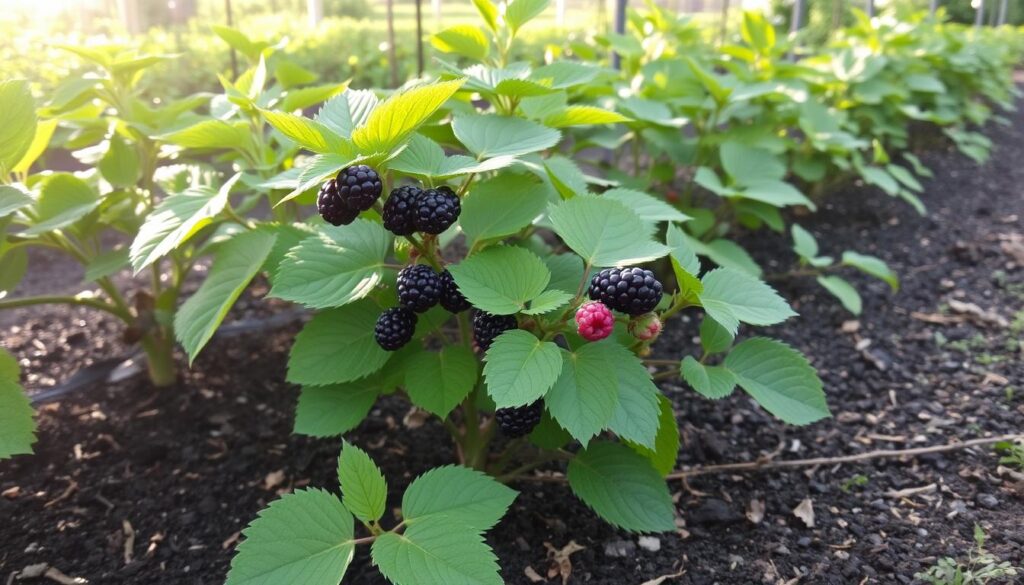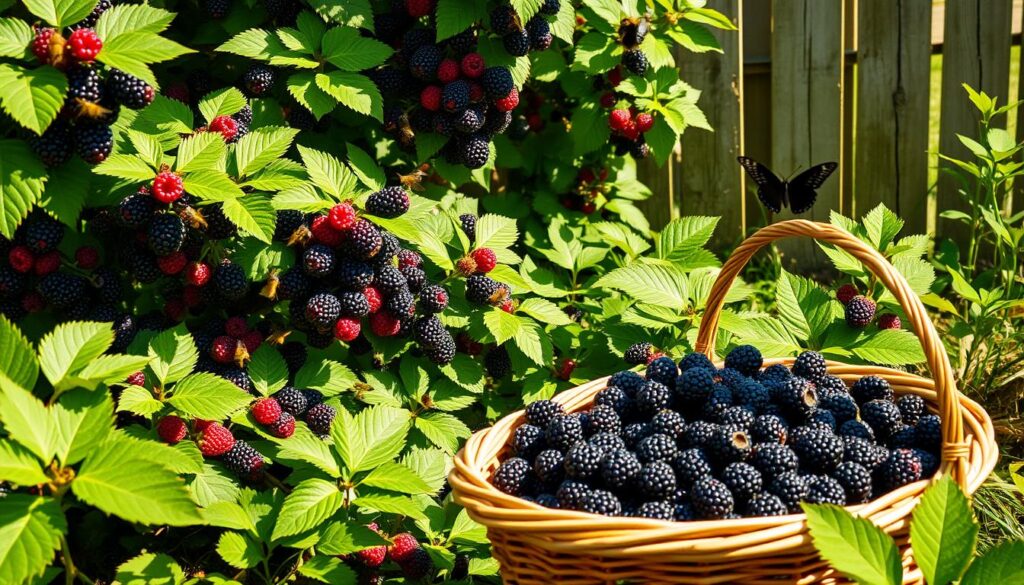Growing blackberries at home is rewarding. It gives me fresh fruit and connects me with nature. These plants are easy to grow, offering plenty of fruit for my cooking. In this guide, I’ll share the best ways to grow blackberries at home. I’ll cover essential tips for beginners in blackberry gardening.
Key Takeaways
- Choosing the right variety of blackberries is crucial for successful growth and fruiting.
- Sunlight exposure of at least six hours daily is essential for healthy production.
- Optimal soil conditions and water requirements play a significant role in plant health.
- Regular pruning and appropriate spacing can enhance berry yield.
- Fungal disease resistance is vital to prevent crop loss in blackberries.
Introduction to Blackberry Gardening
Blackberry gardening is a fun way to grow tasty and healthy berries. It also offers many health benefits. Growing blackberries at home lets you enjoy picking your own fruit. They grow well in many places, making it easy to have a steady supply all summer.
One big benefit of blackberry cultivation is how well they adapt. They need well-drained soil with a pH of 6.0 to 6.7. You can grow them in big gardens or even in pots, perfect for small spaces. Growing blackberries at home helps me improve my gardening skills and enjoy fresh berries from my yard.
Knowing how to space blackberry plants is key. I keep plants three to four feet apart and rows eight to twelve feet apart. This makes them grow well and easier to care for. It’s rewarding to grow lots of berries and keep my gardening skills sharp.
Choosing the Right Variety of Blackberries
Starting my blackberry garden means picking the right variety first. I must decide between thorny and thornless blackberries. Each type has its own benefits and challenges, depending on what I need.
Thorny vs Thornless Varieties
Thorny blackberries and thornless ones are quite different. Thornless types like ‘Arapaho’ and ‘Navaho’ make harvesting easier and safer. They still give lots of fruit without the risk of getting pricked.
On the other hand, thorny varieties like ‘Kiowa’ grow bigger fruits. But, their thorns can make picking them harder.
Popular Blackberry Cultivars
Some blackberry varieties are more popular than others. ‘Ouachita’ is loved for its sweet, big fruits and disease resistance. ‘Apache’ is also a top choice for its high yield, especially among thornless types.
Other great options include ‘Osage,’ ‘Natchez,’ and the ‘Prime-Ark’ series. These varieties are known for their quality and performance. Knowing these details helps me pick the best blackberries for my garden.
Site Selection for Blackberry Plants
Choosing the right spot for blackberry plants is key to their growth and fruit. It’s important to think about sunlight and soil. With the right spot, I can grow healthy blackberries that produce lots of fruit.
Importance of Sunlight Exposure
Blackberries love lots of sunlight. I need to place my plants where they get at least six hours of direct sun each day. Without enough sun, they grow poorly and produce smaller, less tasty berries. Finding a spot with plenty of sun is crucial for a good harvest.
Soil Requirements for Optimal Growth
Blackberries also need the right soil. They do best in well-drained, fertile soil that’s slightly acidic. The best soil types are loam or sandy loam, which help with drainage and nutrient uptake. To make the soil better, I add compost or aged manure. If the soil is too heavy, I mix in more organic material to help with drainage and root growth.
| Soil Characteristics | Optimal Range |
|---|---|
| pH Level | 5.5 – 6.5 |
| Soil Type | Loam or Sandy Loam |
| Drainage | Well-Drained |
| Organic Matter | Amendments recommended |
Thinking about sunlight and soil is important for growing blackberries. With the right spot, I can expect a big harvest.
Best Techniques for Growing Blackberries at Home
To grow blackberries well, you need to focus on spacing and the best planting time. These steps help your blackberries grow strong and produce lots of fruit.
Proper Spacing for Healthy Growth
Spacing blackberry plants right is key for a good harvest and healthy plants. I space them 5 to 6 feet apart. This lets each plant grow without being too close.
This setup helps air move around and gets the plants enough sunlight. Both are important to avoid diseases. I also space rows 5 to 8 feet apart for better air flow. Planning this helps my blackberry bushes stay healthy.
When to Plant Blackberry Plants
The best time to plant blackberries is in early spring when they’re still asleep. This avoids damage from frost. Planting too soon can harm the roots from cold.
Planting too late can slow down the roots’ growth. While fall planting might work in some places, check your area first. Keeping the temperature moderate helps prevent winter damage and supports strong growth.

Preparing Soil for Blackberry Planting
Starting a blackberry garden means getting the soil right. Adding the right soil amendments helps blackberries grow well and produce more fruit. With the right prep, my blackberries will flourish.
Amending Soil for Nutrient Richness
To help blackberries grow strong, I need to add nutrient-rich soil. Compost or manure improves the soil’s structure and nutrients. I’ll dig a foot deep to mix these amendments well.
This makes the soil hold more water but also drain well. Both are key for blackberries.
Maintaining Soil pH Levels
Keeping an eye on the soil’s pH is crucial for blackberries. They do best in slightly acidic soil, with a pH of 5.5 to 6.5. Testing soil pH helps me know if I need to adjust it.
If the pH is too high, I can use sulfur or peat moss to lower it. This ensures my plants get the nutrients they need for growth and fruit.
| Soil Type | Texture | Water Retention | Nutrient Level |
|---|---|---|---|
| Clay | Very fine particles | High moisture retention | Moderate |
| Silt | Fine particles | Moderate | High |
| Loam | Mix of sand, silt, clay and organic matter | Well balanced | High |
| Sandy | Large, visible particles | Low moisture retention | Low |
By adding the right materials and keeping the pH just right, I can make a great home for my blackberries. This prep is key to my success in growing fruit.
Planting Blackberry Bushes
Planting blackberry bushes is a thrilling way to grow tasty berries in my garden. It’s key to follow certain steps for successful planting. I start by picking the best spot, looking for a place that gets 6 to 8 hours of sunlight a day. This helps the plants grow well and produce more fruit.
Steps for Successful Planting
Here are the main steps to plant blackberry bushes:
- Dig a hole big enough for the roots, making sure they have room to spread.
- Soak the new plants in water for a few hours to help them adjust.
- Put the roots in the hole quickly, keeping them out of the sun.
- Plant the bushes 5 to 6 feet apart, with holes 3 feet apart for growth.
- Make sure the plants are straight in the holes before filling with soil.
Watering Immediately After Planting
After planting, it’s important to water the blackberry bushes right away. I give them 1 to 2 inches of water to soak the roots deeply. In the first few weeks, I water them often to keep the soil moist. This care helps the roots grow strong and prepares for a good harvest later.
| Step | Description |
|---|---|
| 1 | Dig a hole appropriate for the roots’ spread |
| 2 | Soak plants prior to planting to reduce transplant shock |
| 3 | Avoid exposing roots to sunlight during planting |
| 4 | Space plants adequately for mature growth |
| 5 | Water thoroughly and consistently after planting |
Caring for Blackberry Plants
Keeping blackberry plants healthy means paying attention to watering and mulching. These steps are key for growth and fruit. Following good watering tips can make your plants strong and healthy.
Watering Guidelines for Healthy Growth
Blackberries need steady moisture to grow well. I use specific watering tips to help them grow. During the growing season, I give them about 1 inch of water a week.
When they’re ripening fruit, I increase it to 2 inches. It’s important to keep the soil moist but not too wet. Too much water can harm the roots.
Using Mulch to Conserve Moisture
Mulch helps keep blackberry plants moist. I use organic mulch like pine bark or straw. It keeps moisture in and stops weeds.
Putting on a 3-inch layer in spring helps a lot. It protects the soil and makes it healthier as it breaks down. This makes my garden easier to care for and helps my blackberries grow better.
| Practice | Description | Benefits |
|---|---|---|
| Watering | 1 inch of water weekly; increase to 2 inches during fruit ripening. | Ensures healthy growth and fruit production. |
| Mulching | Apply organic mulch about 3 inches thick in spring. | Retains moisture, suppresses weeds, and enriches the soil. |
For more tips, check out GardenBeginner.com. They have lots of gardening advice and techniques.
Fertilization for Maximum Yield
Effective fertilization is key to getting the most from my blackberry plants. Choosing the right fertilizer and following a detailed fertilization schedule boosts growth and fruit. Knowing when and how to fertilize helps me get a big harvest.
Choosing the Right Fertilizer
For blackberries, a balanced fertilizer like 10-10-10 is best. It gives the plants the nutrients they need for strong growth and fruit. I start using fertilizer after the first year to avoid harming the plants.
Fertilization Schedule for Best Results
The best time to start feeding blackberries is in late spring when they grow new leaves. I spread the fertilizer around the base of each plant to avoid burning the roots. I also give them a light feeding after the harvest to keep them nourished.
For more tips on fertilizing blackberries, I check out Gardening Know How. A good fertilization plan helps me get a big harvest.
Pruning Techniques for Blackberry Plants
Proper pruning is key for blackberry plants’ health and productivity. I use blackberry pruning tips to keep my plants healthy and ensure a good yield every year. Knowing when and how to prune greatly affects blackberries’ growth and fruiting.
When and How to Prune
For floricane-bearing varieties, I start pruning blackberries after the harvest. I remove dead or weak canes and leave the first-year canes unpruned. This lets them grow fully.
If I’m caring for erect or semi-erect varieties, I cut the main canes to 3-4 feet in midsummer. This helps promote healthy lateral branching in blackberries.
Encouraging Lateral Branching
To boost future yields, I pinch the tips of young primocanes when they’re about three feet tall. This encourages lateral branching in blackberries, which is crucial for more fruit.
My summer pruning helps grow stronger canes, making berry harvesting easier and more fun. In the fall, once the plants are dormant, I shorten the laterals to 16-18 inches. This prepares them for a rich harvest the next summer.
Harvesting Blackberries
Learning when and how to pick blackberries can really boost my harvest. This guide helps me watch the berries closely as they ripen. I look for a shiny black color and soft feel, which means they’re ready. It’s important to pick them when they’re ripe, usually from mid-summer to early fall.
Picking every few days helps me get the best berries. Blackberries don’t get riper after they’re picked, so it’s key to pick them when they’re at their best.
When to Pick Blackberries
During the picking season, I watch for signs of ripeness. These include:
- Color: Berries should be a deep, shiny black.
- Texture: A slight softness means they’re ripe and ready.
- Detachment: Ripe blackberries will easily come off the stem.
Knowing when to pick helps me get more and better berries.
Tips for Proper Harvesting Techniques
Using the right ways to pick blackberries keeps them fresh. Here are some tips:
- Pick in cooler times, like early morning or late afternoon, to keep berries fresh longer.
- Gently twist or pull the berries from the vine to avoid bruising them.
- Use shallow containers to collect berries without squishing them.
Following these tips keeps my berries in top shape. They’re ready to eat right away or to save for later.
Disease and Pest Management for Blackberries
Keeping blackberry plants healthy means watching out for diseases and pests. I know how to spot common problems and fix them. This way, my blackberry garden stays strong and vibrant.
Common Diseases Affecting Blackberry Plants
Blackberry diseases can really hurt plant health and how much they produce. Some big problems are:
- Anthracnose, which causes round spots on canes and can kill them off.
- Fruit rot, making fruits and blossoms turn gray and moldy.
- Powdery mildew, showing up as a white, powdery stuff on leaves and buds.
- Orange rust, making leaves weak and deformed with orange spots.
- Crown gall, causing growth problems by forming galls on branches.
To fight blackberry diseases, I choose plants that are less likely to get sick. I also check my plants often for any signs of disease. Keeping them healthy and well-ventilated helps a lot.
Pest Control Strategies
Controlling pests in blackberries is key to keeping plants healthy. Some pests to watch out for are:
- Aphids, tiny bugs that suck plant sap and cause sticky messes.
- Cane borers, which leave sawdust trails.
- Japanese beetles and rose chafers, eating away at leaves.
- Thrips, tiny bugs that poke holes in leaves and eat their insides.
To keep pests away, I check my plants often and remove any sick parts. If pests get too bad, I might use organic pesticides. This way, I keep my blackberry plants healthy and happy.
Benefits of Growing Blackberries at Home
Growing blackberries at home brings many benefits to my gardening. One big reason is getting fresh, organic fruit right from my garden. This means I eat healthy berries without pesticides and enjoy them at their best taste.
Blackberries are also great for my health. They are full of nutrients and antioxidants. The benefits of homegrown blackberries go beyond taste; they help my immune system and overall health. Adding them to my meals makes them more nutritious and tasty.

Growing my own blackberry plants teaches me a lot about gardening. I learn about plant care, like pruning and trellising. It’s rewarding to watch them grow and produce fruit. Plus, it saves me money on buying berries from the store.
If you’re thinking about growing blackberries, learning about growing upright can be very helpful. The joy, health perks, and saving money make it a great choice. Whether I eat them fresh or save them for later, growing blackberries is very rewarding.
Conclusion
To grow blackberries at home, you need a plan. This includes picking the right variety, planting it correctly, and caring for it well. Successful blackberry gardening means knowing what each variety needs. This way, you can get a big harvest.
Good care is more than just planting. It’s about pruning, mulching, and fertilizing regularly. Choosing thornless varieties can make picking easier and increase your yield. This way, you can enjoy fresh blackberries from your garden.
To get the most from your blackberry plants, you must care for them all year. Be ready to change your approach as needed. Keeping up with new tips and advice helps you enjoy blackberries even more. For more help, check out the Contact page to connect with other gardeners.



Leave a Reply